To guarantee your infant's safety during sleep, follow these necessary practices. Use a firm mattress that fits snugly in the crib and keep it free of hazards like soft bedding, toys, and loose items. Always place your baby on their back to sleep and avoid bed-sharing, while room-sharing is recommended for the first six months. Maintain a comfortable room temperature between 68°F to 72°F and check your baby's warmth. Following healthcare guidelines is vital for a safe sleep environment. By adhering to these practices, you'll create a secure space for your infant, while delving into further insights can enhance your knowledge.
Key Takeaways
- Always place your baby on their back to sleep to reduce the risk of Sudden Infant Death Syndrome (SIDS).
- Use a firm mattress that fits snugly in the crib, avoiding soft bedding, pillows, and stuffed animals.
- Maintain a smoke-free environment and avoid placing the crib near windows or cords for safety.
- Keep the room temperature between 68°F to 72°F (20°C to 22°C) and dress your baby appropriately.
- Share your room with the baby for at least the first six months, but avoid bed-sharing.
Choose a Firm Sleep Surface
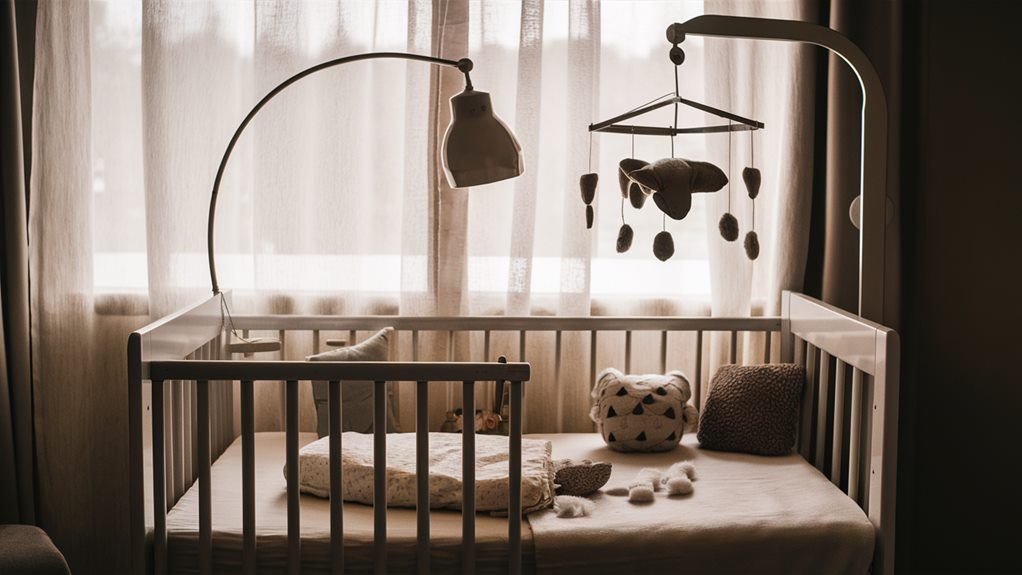
Choosing a firm sleep surface is fundamental for your infant's safety and well-being. When picking a crib or bassinet, you must prioritize a suitable mattress that complies with established safety standards. A firm mattress provides the necessary support, reducing the risk of suffocation and other sleep-related hazards.
Additionally, consider that some products, like baby bottle warmers, also emphasize safety features to guarantee a secure environment for your child safety features in bottle warmers.
It's vital to make sure that the mattress fits snugly within the crib or bassinet frame. A gap between the mattress and the sides can pose serious dangers, allowing your baby to become trapped. The American Academy of Pediatrics recommends that you use a mattress specifically designed for infants, as these products meet strict safety criteria.
Avoid soft bedding, such as pillows, blankets, or bumper pads, which can increase the likelihood of accidental suffocation.
When choosing a suitable mattress, consider materials that are both firm and breathable. High-density foam or innerspring mattresses are commonly recommended, as they offer the right balance of support and comfort.
Regularly inspect the mattress for any signs of wear or damage, as a compromised surface can lead to safety risks.
Always Place Baby on Back

One of the most vital safe sleep practices for infants is always placing them on their backs for sleep. This sleep position notably reduces the risk of Sudden Infant Death Syndrome (SIDS), a concerning issue for parents and caregivers. Research consistently shows that babies who sleep on their backs are less likely to experience SIDS compared to those who sleep on their stomachs or sides. Additionally, using a dependable baby monitor can enhance peace of mind, as some models offer features like night vision and two-way audio for monitoring your baby while they sleep (5 Best Baby Monitors).
When you position your baby on their back, you're promoting a safer sleep environment. The back sleep position helps keep the airway clear and reduces the chance of the baby rebreathing carbon dioxide, which can happen if they're face down. It's crucial to establish this practice from the very beginning, as infants are more vulnerable during the first year of life.
You might worry that your baby will roll over, but it's important to mention that once your infant can roll independently, they can choose their preferred sleep position. Regardless of this ability, you should always place them on their back initially, as this habit remains a key preventive measure against SIDS risk.
In addition, maintaining a consistent sleep routine reinforces this behavior. It's a simple yet impactful step you can take to ensure your baby's safety during sleep. By prioritizing this practice, you're not only nurturing a sense of security but also joining a community of caregivers dedicated to providing the safest environment for their little ones.
Keep Crib Free of Hazards

A safe crib is crucial for your baby's sleep environment, as it greatly reduces the risk of accidents and injuries. To prioritize your infant's sound sleep, you must prioritize hazard prevention by keeping the crib free of any potential dangers. Start by removing any loose bedding, pillows, or stuffed animals. These items can pose suffocation risks, disrupting your baby's safe sleep habits. Additionally, consider using a top-notch crib mattress that meets safety standards, guaranteeing a firm and supportive sleep surface for your baby.
Next, check the crib's structural integrity. Make sure that the slats are no more than 2.375 inches apart to prevent your child's head from getting stuck. A firm mattress that fits snugly within the crib is essential; it shouldn't leave any gaps where your baby could become trapped. Regularly inspect the crib for any sharp edges or protruding hardware that could cause injury.
Avoid placing the crib near windows, blinds, or cords that your baby might reach. These items can present strangulation hazards. Additionally, keep toys and other items off the crib's sides to minimize distractions during sleep, fostering a calm environment.
Lastly, it's important to follow manufacturer guidelines when assembling and maintaining the crib. This adherence ensures that you're using the product as intended, enhancing safety. By focusing on hazard prevention and cultivating safe sleep habits, you're creating a nurturing space for your infant to thrive. Remember, a well-maintained, hazard-free crib is a fundamental aspect of your baby's overall well-being.
Room Sharing Recommendations
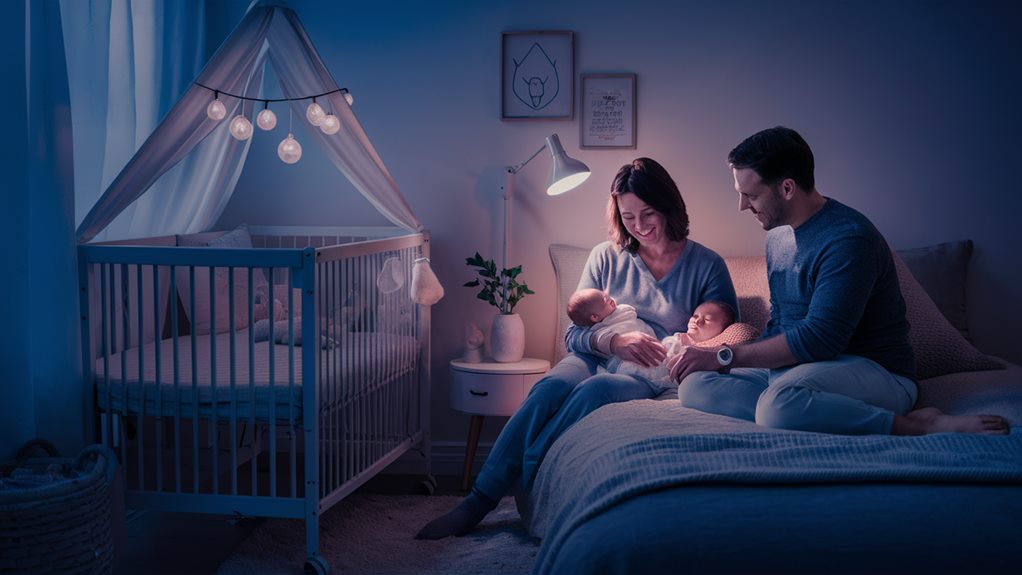
Sharing a room with your infant can greatly boost their safety and your peace of mind during sleep. It's recommended that you keep your baby in your room for at least the first six months, ideally up to a year. This practice not only fosters bonding but also allows you to monitor their sleep position more easily. Infants are at a heightened risk for sleep-related incidents, and being close by enables you to respond quickly if needed.
When you create a safe sleep environment, make sure your baby sleeps in a crib, bassinet, or play yard that meets current safety standards. Position the crib or bassinet close to your bed to make nighttime feedings and soothing more convenient, while still having a separate sleep space for your infant.
Always place your baby on their back to sleep, as this is the safest sleep position that reduces the risk of Sudden Infant Death Syndrome (SIDS).
As you prepare the room, keep the sleep environment free from distractions and excessive noise. A calm atmosphere can help promote better sleep for both you and your infant. Avoid using soft bedding or toys in the sleep area, as these can pose risks. Instead, focus on maintaining a comfortable temperature and using a firm mattress. By adhering to these room-sharing recommendations, you can create an ideal sleep environment that enhances safety and nurtures your bond with your baby.
Avoid Soft Bedding and Toys
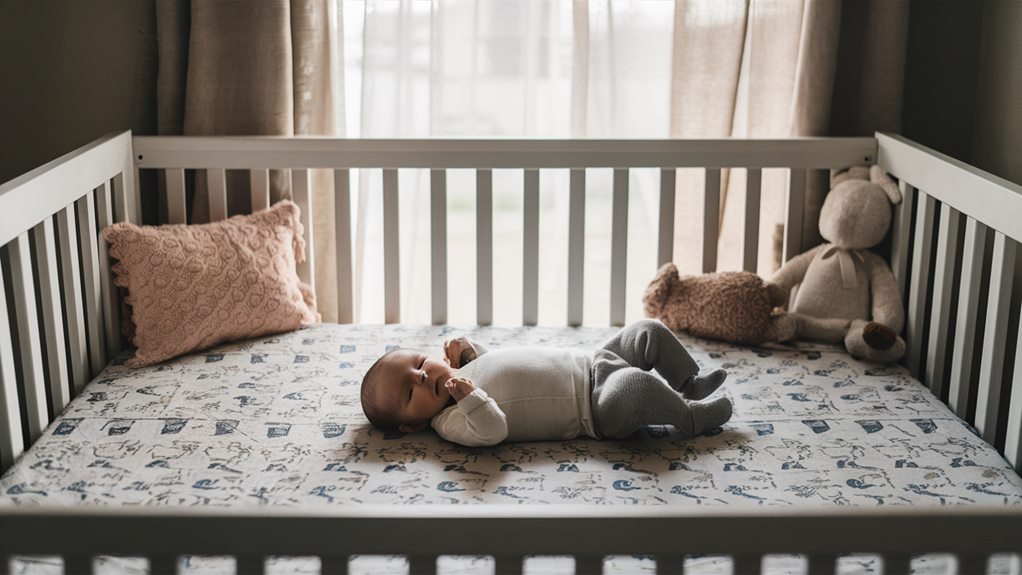
Since infants are particularly vulnerable during sleep, it's important to avoid soft bedding and toys in their sleep area. The risk of suffocation increases significantly when infants are surrounded by items that can obstruct their airways. To guarantee your baby's safety, implement blanket restrictions by using only a fitted sheet on the crib mattress and avoiding loose blankets that can pose a danger.
Soft bedding, including comforters, pillows, and bumper pads, should be eliminated from your infant's crib. These items may seem cozy, but they create an unsafe environment. Instead, consider swaddling your baby with a lightweight, breathable fabric that keeps them snug without the risk of suffocation. Remember, your infant's sleep space should be as simple and safe as possible.
Toy removal is another important step in creating a secure sleep environment. While toys are typically associated with play and comfort, they can become hazards during sleep. Stuffed animals, plush toys, and even decorative items should be kept out of the crib. Your baby's sleep area should be free from distractions that could lead to movement or rolling over, which can further increase the risk of suffocation.
Monitor Room Temperature
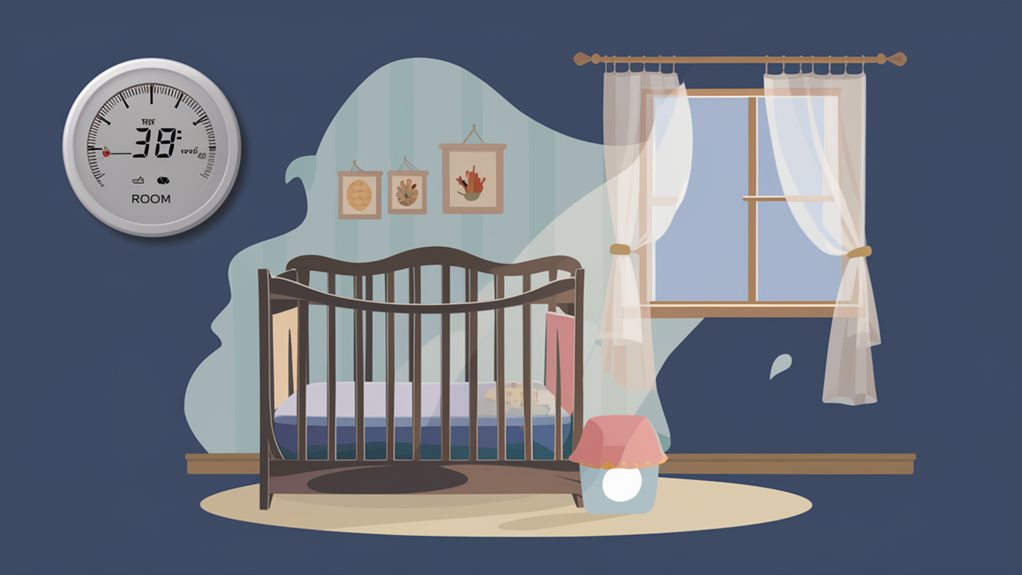
Creating a safe sleep environment extends beyond removing soft bedding and toys; monitoring room temperature is equally significant. Infants haven't yet developed effective temperature regulation, making them more vulnerable to overheating or becoming too cold during sleep. Maintaining an appropriate temperature in your child's sleep area is vital for their overall safety and well-being.
To achieve ideal room temperature, aim for a range between 68°F and 72°F (20°C to 22°C). You can use a reliable thermometer to monitor this range. Confirm your thermometer's accuracy by regularly checking it against another trusted device; this will help you maintain a safe environment for your infant.
When evaluating the comfort level of your baby's sleep space, don't solely rely on the thermostat. Regularly feel your baby's neck or back to check if they're too warm or cold. It's crucial to adjust your child's clothing and bedding accordingly, as they may require lighter layers in warmer months and heavier options during colder seasons.
Additionally, make sure that your infant's sleep area is well-ventilated but not drafty. A stable temperature helps reduce the risk of Sudden Infant Death Syndrome (SIDS), promoting a healthier sleep environment.
Follow Health Care Guidelines
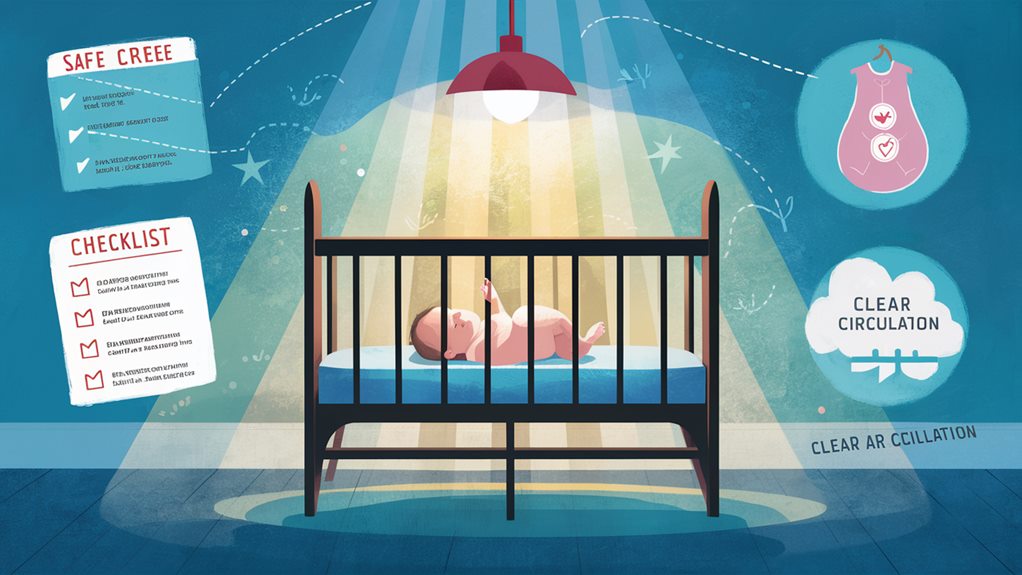
To ensure your infant's safety during sleep, it's vital to follow established health care guidelines regarding sleep practices. These guidelines are created by experts who prioritize safety and are based on extensive research. Adhering to these recommendations not only enhances your child's safety but also provides you with peace of mind as a parent.
First, always place your baby on their back for every sleep, whether in a crib, bassinet, or play yard. This position markedly reduces the risk of Sudden Infant Death Syndrome (SIDS). Make sure the sleep surface is firm and free from soft bedding, pillows, or toys that could pose suffocation hazards.
It's crucial to maintain a smoke-free environment. Smoking during pregnancy and around your infant increases SIDS risk.
Also, consider room-sharing without bed-sharing, as it helps you monitor your baby while reducing the likelihood of accidents.
Don't hesitate to seek advice from your healthcare provider about safe sleep practices. They can offer tailored guidance based on your baby's specific needs and any concerns you may have. Consulting healthcare professionals signifies that you're well-informed, allowing you to prioritize safety effectively.
Frequently Asked Questions
When Can I Transition My Baby to a Crib From a Bassinet?
You can usually switch your baby to a crib around 3 to 6 months, but it depends on their development. Make sure the room temperature is comfortable and adheres to safety guidelines.
Before making the switch, familiarize yourself with crib safety—like using a firm mattress and avoiding soft bedding.
To make the move smoother, gradually introduce the crib during naps. This helps your baby adjust, creating a secure sleep environment they'll eventually love.
What Should I Do if My Baby Rolls Over While Sleeping?
What happens when your baby rolls over while sleeping? It's a moment that can spike anxiety.
First, make sure your baby's sleep position is safe. If they're rolling, it's important to minimize the rolling risk. You can use a firm mattress and avoid soft bedding.
Always place your baby on their back to sleep, as this promotes safety. Keep an eye on them during sleep to enhance prevention and guarantee peace of mind.
How Can I Safely Travel With My Infant for Sleep?
When traveling with your infant for sleep, make sure you've got a secure car seat for the journey. Once you reach your destination, set up a portable crib in a safe space.
It's important that the crib meets safety standards and provides a familiar sleep environment for your baby. Avoid placing any soft bedding or toys inside.
Consistency helps your infant feel secure, so try to stick to their usual sleep routine whenever possible.
What Are the Signs My Baby Is Too Hot or Cold?
Did you know that over 60% of infants struggle with temperature regulation during sleep? To guarantee your baby's comfort, monitor their sleep environment closely. Signs they're too hot include sweating, flushed skin, or rapid breathing, while cold symptoms might be pale skin, cold extremities, or fussiness. Adjust their clothing and bedding accordingly, aiming for a cozy space where they can sleep soundly and safely, keeping their temperature just right.
Can I Use a Baby Monitor for Added Safety During Sleep?
Using a baby monitor can enhance your peace of mind while your baby sleeps. Video monitoring offers a clear view of your infant, allowing you to check on them without entering the room. However, consider privacy implications, especially with smart devices.
Audio monitoring is also beneficial, but make sure it has a good range to pick up subtle sounds. Ultimately, choose a monitor that fits your family's needs while prioritizing your baby's safety and comfort.
Conclusion
By implementing these seven important safe sleep practices, you can greatly reduce the risk of sleep-related incidents for your infant. Think of your baby's sleep environment as a stronghold, where only the safest practices prevail. Remember, a firm sleep surface and room sharing can be as important as a knight's armor in protecting your little one. Prioritizing these guidelines not only guarantees your baby's safety but also promotes their healthy development. Always consult healthcare professionals for personalized advice.

